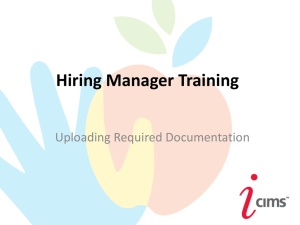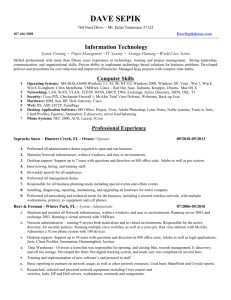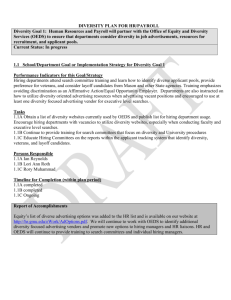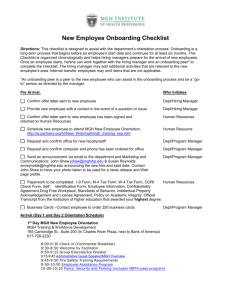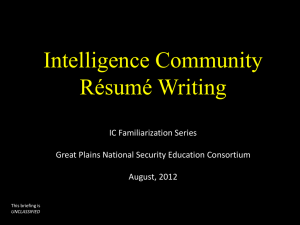Chapter 3 Employee Orientation and Training
advertisement
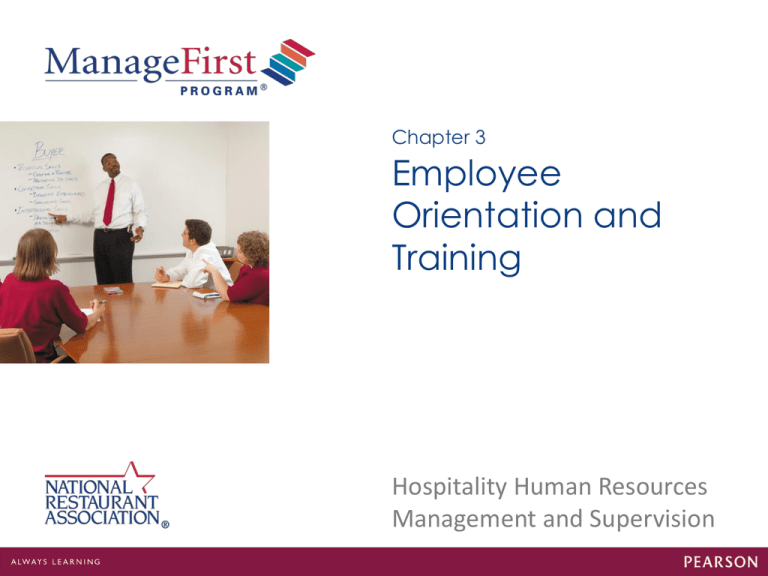
Chapter 3 Employee Orientation and Training Hospitality Human Resources Management and Supervision Learning Objectives After completing this chapter, you should be able to: • Review basic procedures that should be used for employment and payroll documentation. • Explain basic procedures that should be included in hiring and orientation activities. • Describe how to plan and evaluate orientation programs. • Explain procedures for planning and delivering training programs. Chapter 3 Employee Orientation and Training EMPLOYMENT AND PAYROLL DOCUMENTATION Required Employment and Payroll Documents Benefit Enrollment Documents Chapter 3 Employee Orientation and Training Chapter 3 Employee Orientation and Training Personnel Files Chapter 3 Employee Orientation and Training HIRING AND ORIENTATION ACTIVITIES Timing of Hiring and Orientation Activities Hiring and Orientation Checklists Chapter 3 Employee Orientation and Training Chapter 3 Employee Orientation and Training New Hire Checklist Chapter 3 Employee Orientation and Training Orientation Checklist Chapter 3 Employee Orientation and Training ORIENTATION PROGRAMS Planning Orientation Programs Time Frame Content and Structure Materials and Resources Trainers and Other Contributors Chapter 3 Employee Orientation and Training Employee Handbooks Chapter 3 Employee Orientation and Training Evaluating Orientation Programs Chapter 3 Employee Orientation and Training EMPLOYEE TRAINING PROGRAMS Benefits of Training Job Skills Improvement Other Benefits Chapter 3 Employee Orientation and Training Principles of Training Content Based on Job Guidelines Clearly Stated Learning Objectives Qualified and Thoroughly Prepared Trainers Sufficient Practice Effective Training Evaluation Chapter 3 Employee Orientation and Training Determine Training Needs Develop Training Plans and Training Lessons Four-Step Training Method Preparation Presentation Practice Performance Chapter 3 Employee Orientation and Training Integrative Practice Chapter 3 Employee Orientation and Training Group Training Industry-Recognized Training Chapter 3 Employee Orientation and Training - Summary 1. Review basic procedures that should be used for employment and payroll documentation. • Major hiring documents are those for employment and payroll and for benefit enrollment. • Employee documents include the W-4 form, state and local tax forms, and the I-9 form. • Other documents may be required depending on age and position. • Job eligibility documents and permission documents to check references and background may also be needed. • Benefit enrollment documents enable employees to enroll in life insurance or other benefit plans. • Information about retirement benefits, if any, should also be provided. Chapter 3 Employee Orientation and Training - Summary 1. Review basic procedures that should be used for employment and payroll documentation continued… • Most hiring and orientation documents should be kept in a personnel file. • These confidential files should be stored in a safe, secure, and private place. Chapter 3 Employee Orientation and Training - Summary 2. Explain basic procedures that should be included in hiring and orientation activities. • Managers must ensure that all required paperwork is completed and that the mission and culture of the establishment have been emphasized. • Company policies, procedures, and the employee handbook should be reviewed and the new employee should receive a uniform, name tag, tools, and so on as appropriate. • A facility tour should be provided, the new employee should be introduced to coworkers, and information about job responsibilities, expectations, and the first week’s work schedule should be addressed. • Organizations manage hiring and orientation differently, but both tasks are necessary within a short time after employees begin work. • Regardless of procedures used, the documentation of new employees will be processed, and they will be oriented to the organization. Chapter 3 Employee Orientation and Training - Summary 2. Explain basic procedures that should be included in hiring and orientation activities continued… • Some establishments use checklists to manage the flow of documents and activities. • These help ensure that all legal, payroll, and policy requirements are met. Chapter 3 Employee Orientation and Training - Summary 3. Describe how to plan and evaluate orientation programs. • The two main purposes of orientation programs are to provide the information a new employee needs, and to make the employee feel comfortable. • Consistency is important to meet safety and legal obligations. • Every new employee should receive the same information, learn the same safety practices, have the same opportunities to learn about the operation, and meet the same key people. • Managers and others planning orientation should consider the time necessary, program content and structure, materials and resources needed, and the trainers who will conduct the program. • Employee handbooks address basic information including policies. • Employee handbooks should be kept updated. Chapter 3 Employee Orientation and Training - Summary 3. Describe how to plan and evaluate orientation programs continued… • Orientation programs are evaluated to determine whether participants completed all documents and gained the knowledge needed to start their new jobs. • Managers can talk with new employees to obtain feedback, and employees can also complete evaluation forms. Chapter 3 Employee Orientation and Training - Summary 4. Explain procedures for planning and delivering training programs. • Training is required for new employees and is useful for experienced staff. • Effective training helps employees buy into the operation’s values. • It creates product and service consistency, increases employee morale, and helps reduce turnover and legal liabilities. • Employees can learn how to properly handle food and potential hazards. • Customer satisfaction and profitability increase. • Each task should be explained to the new employee, and he or she should be shown how to complete the task. • The employee should then be observed performing the task and feedback should be provided. • Clearly stated learning objectives based on a job’s essential functions drive training programs. Chapter 3 Employee Orientation and Training - Summary 4. Explain procedures for planning and delivering training programs continued… • Sessions should be conducted by qualified and prepared trainers. • Managers can determine training needs by observing work performance, receiving input from employees and customers, making inspections, analyzing information, and conducting exit interviews. • Training plans organize program content and individual lessons that provide a “road map” for the training. • Training must be evaluated and validated to ensure effectiveness. • A four-step training method involves preparation, presentation, practice, and performance. • In addition, integrated practice allows trainees to combine and demonstrate several steps that are part of a job task. • Group training can be used when more than one employee must receive the same information. • The basic planning steps used for one-on-one training can be used. Chapter 3 Employee Orientation and Training - Summary 4. Explain procedures for planning and delivering training programs continued… • Popular group methods include lecture, demonstration, and practice, if applicable. • A good trainer uses all of these tactics. • Many managers use off-the-shelf training materials. • Sources of external training include the Internet, workshops by training companies, and training opportunities by professional associations. • Other sources include local colleges and social service organizations that provide assistance in learning English. Chapter 3 Employee Orientation and Training Key Terms: Employee handbook A description of job requirements and an establishment’s policies that is given to new employees. Form I-9 A document stating that an employee is legally able to work in the United States, to be completed before beginning work and being placed on the payroll. Form W-4 A federal tax form that every employee fills out, which is used for payroll and tax withholding purposes. Four-step training method A training method that consists of the following steps: preparation, presentation, practice, and performance. Group training A method used to teach the same job-related information to more than one trainee at the same time. Hiring Tasks relating to employment and benefits documents. Integrative practice A training strategy in which a trainee combines and demonstrates several steps in a job task that has already been learned. Chapter 3 Employee Orientation and Training Key Terms continued: New hire checklist A checklist that is useful for ensuring that all hiring documents are produced or completed. New hire packet A kit that contains copies of documents that are needed and will be discussed during orientation sessions. Off-the-shelf Ready-made training materials that have been developed by associations and other external organizations. Orientation Tasks related to introducing the new employee to the establishment and the job. Orientation buddy A person who serves as an adviser during orientation. Orientation checklist A list of the activities to be addressed during orientation, used to ensure that each new employee has the same orientation experience and a chance to learn about the same topics. Personnel file A confidential file that contains documents related to hiring, training, evaluating, promoting, and, if necessary, disciplining an individual. Chapter 3 Employee Orientation and Training Key Terms continued: Probationary period The time used by the manager to assess whether a new employee can successfully perform the job’s tasks. Standard operating procedure (SOP) Work procedures that explain what employees must know and do when they perform the work specified in their job descriptions. Training lesson The information and methods used to present one session in a training plan. Training objective The skills and knowledge that trainees should learn as a result of the training. Training plan A plan that shows how individual training lessons should be sequenced so trainees can learn the required information. Validation The comparison of training content and evaluation methods to the actual job of an employee who can do the work. Chapter 3 Employee Orientation and Training Chapter Images Chapter 3 Employee Orientation and Training Chapter Images continued Chapter 3 Employee Orientation and Training Chapter Images continued


